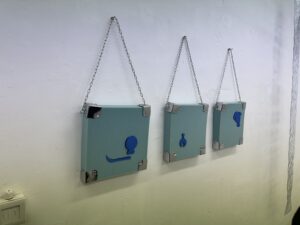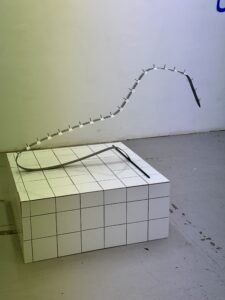Class summary and thoughts on Summerhall visit
In contemporary art and curating, the interplay between place, community engagement, and innovative artistic strategies is crucial. Lectures by teacher Francis Davis and Summerhall’s Director of Visual Arts and Film Curator Sam Chapman deepened my perception of how art can interact with communities and spaces beyond traditional constraints (Sotheby’s Institute of Art, 2018; Art File Magazine, 2023). Francis Davies’ discussion of the nomadic cultural organization ATLAS Arts made me aware of the necessity of how location shapes art projects.ATLAS Arts facilitates a range of community-centered art projects by drawing on the unique geographic and communal context of the north-west coast of Scotland, an approach that confirms how, in the absence of a fixed space, art can engage with local environments and social structures resonate (ATLAS Arts, 2022).
In addition to the presentations and exhibitions I tuned into at summerhall in week five, I researched some of the exhibitions that Summerhall has hosted over the years, including an exhibition of David Williams’ photographs during Covid19 in 2022
Upon exploring Summerhall, a multi-arts complex in Edinburgh, I recognized that this contrasted with ATLAS Arts’ artistic activities in the remote rural areas of Scotland (Summerhall, 2024). Not only did it reveal the broad scope and multiple possibilities of the curatorial field, but it also reflected how art interacts and engages in dialogue with the spaces and communities in which it is situated. Curating as I understand it goes far beyond the traditional presentation of artworks. It is more about creating an environment that fosters dialogue and exchange, an ecosystem where the public can directly participate and feel the impact of art. This participation deepens the overall sense of community engagement and enhances the resonance of the artworks. By comparing ATLAS Arts and Summerhall, I was able to witness how the way art interacts in different environments shapes and reflects the current cultural dynamics of society (Lind, 2021; Sotheby’s Institute of Art, 2018). This contrast not only demonstrates the diversity of geographical and cultural contexts in curatorial practice, but more importantly, it emphasizes the significance of the curator’s role in building bridges between art and the public. The curator is not only a presenter of artworks, but also a cultural transmitter and a medium of communication with the community. Their work requires not only an in-depth understanding of art but also a keen sense of the needs and expectations of the community to ensure that the artwork can create a real connection with the audience. This requires us as curators to constantly innovate in order to adapt to the ever-changing social and cultural landscapes, as well as a higher level of foresight, the ability to anticipate and guide future art trends and social changes.







Random shots from a visit to some of Summerhall’s specific pavilions, including pieces that struck me as reminiscent of the pain of driving steel nails into bones, which were placed in a space that had previously served as an animal morgue
Through my practice, I have not only been able to better understand the complexities of contemporary curating but also to recognize the crucial role of art in shaping society and culture. This prompts us as curators, artists, and even audiences to be more actively involved in the interaction between art and the community, and to promote wider cultural dialogue and social participation in innovative ways. In addition, the role of modern museums is to preserve and present contemporary art while ensuring the accessibility of artworks to a diverse audience, which is an important role for curators (Anita Louise Art, n.d.). Museums of contemporary art not only present creative works but also translate abstract expressions into experiences that are accessible to audiences, while emphasizing the importance of inclusivity and interpretive challenges (Anita Louise Art, n.d.).
In my future curatorial practice, I will also carry the lessons learned from Frances Davis and Sam Chapman with me as I continue to explore ways to integrate art into the community and create more inclusive and interactive spaces through curation.
References:
ATLAS Arts. (2022). ATLAS Arts Strategic Plan 2022-2026
Lind, M. (2021). “Situating the Curatorial”, e-flux Journal, (116)
Sotheby’s Institute of Art. (2018). Trends in Contemporary Curating. Available at: https://www.sothebysinstitute.com/news-and-events/news/trends-in-contemporary-curating (Accessed 2024-02-19)
Art File Magazine.( 2023). “What Is Curating in Art? – Creating Impactful Art Collections”. Available online: https://www.artfilemagazine.com/what-is-curating-in-art/ (Accessed 2024-02-22)
Summerhall. (2024). “About Summerhall”. Available online: https://www.summerhall.co.uk/about/ (Accessed 2024-3-1)
Anita Louise Art. (n.d.). “Exploring Contemporary Art in Museums”. Available online: https://www.anitalouiseart.com/exploring-contemporary-art-in-museums/ (Accessed 2024-02-16)
First Edit
22nd February 2024
———————————————————————————————
In our panel discussion, we delved into the distinction between principles and values in projects, which is closely related to art curation. As discussed by Gilda Williams in How to Write About Contemporary Art (Williams, 2014), the key to effectively communicating contemporary art is to clearly articulate these values and principles in order to guide readers and viewers towards a deeper understanding of the context and meaning of the artwork. Meanwhile, the curatorial practice proposed by Hans Ulrich Obrist in A Brief History of Curating (Obrist & Bovier, 2008) emphasises the social and cultural importance of collaborating with artists and explaining contemporary art to the public, which echoes the values of cross-cultural respect and political critique identified by our group.
In addition, we discuss how these values are applied practically in our curatorial projects, which includes integrating cross-cultural elements, political critique, and ensuring material sustainability, practices that reflect the principles emphasised by Hackman (2002) in his book Leading Teams: Setting the Stage for Great Performances, which states that successful teamwork involves the establishment of shared goals and a commitment to achieving them.
References:
Obrist, H.-U. & Bovier, L. (2008). A brief history of curating. JRP / Ringier.
Williams, G. (2014). How to write about contemporary art. Thames & Hudson.
Hackman, J. R. (2002) Leading Teams: Setting the Stage for Great Performances. Harvard Business Review Press.
Second addition
5 March 2024
———————————————————————————————


